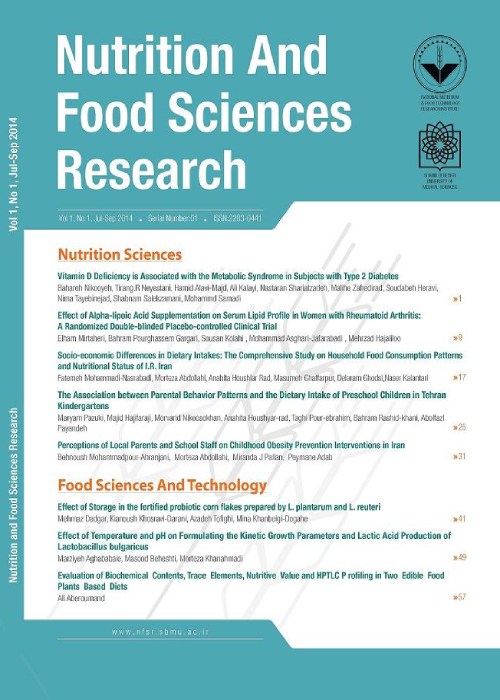Assessment of Dietary Intakes and Food habits in Female Adolescents with Eating Disorders
Author(s):
Article Type:
Research/Original Article (دارای رتبه معتبر)
Abstract:
Background and Objectives
Eating disorders are psychological syndromes which characterized by abnormal or disturbed food habits resulted from intense fear of obesity and may include negative effects on people physical or mental health. This cross sectional study was carried out to assess dietary intakes and food habits in female adolescents with eating disorders in Tehran, Iran.
Materials and Methods
Totally, 231 female adolescent with eating disorders were selected from a total number of 2766 students from five districts in Tehran using multistage clustered sampling in a 2-phase procedure. All affected students and 284 non-affected students filled demographic and food habit questionnaires (modified version) for adolescents and then were interviewed for the 70-item non-quantitative food frequency by expert nutritionists.
Results
Study of dietary patterns in adolescents showed that the most common meal pattern (30%) in non-affected group included three main meals and two snacks. The highest frequent patterns in partial syndrome group (33.5%) and bulimia nervosa (28.1%) included two main meals daily. The missing dinner in partial syndrome and bulimia nervosa groups were significantly higher than that in non-affected group (P<0.05). The highest frequency of drinking water (4–6 cups/day) was seen in partial syndrome group (41%). This included 3–2 cups/day (39% and 42.3%) in bulimia nervosa and non-affected groups, respectively. A significant difference was seen between these groups (P = 0.037). Consumption of all cereals and vegetables in the affected group was significantly lower than that in non-affected group (P < 0.05). Study of lipid intake status in the participants showed that the frequency of low-fat dairy products in affected groups (25% and 35.8% in partial syndrome and bulimia nervosa, respectively) was significantly higher than that in non-affected group (12.7%).
Conclusions
Study demonstrated that missing dinner and drinking higher volumes of water with decreased cereal and low-fat dairies intakes were the major techniques used by the adolescents to reduce the calorie intake. Despite of these differences, the overall food habits in the affected group do not seem different significantly from those in non-affected groups.Keywords:
Language:
English
Published:
Nutrition & Food Technology Research, Volume:5 Issue: 4, Oct-Dec 2018
Pages:
7 to 14
magiran.com/p1905890
دانلود و مطالعه متن این مقاله با یکی از روشهای زیر امکان پذیر است:
اشتراک شخصی
با عضویت و پرداخت آنلاین حق اشتراک یکساله به مبلغ 1,390,000ريال میتوانید 70 عنوان مطلب دانلود کنید!
اشتراک سازمانی
به کتابخانه دانشگاه یا محل کار خود پیشنهاد کنید تا اشتراک سازمانی این پایگاه را برای دسترسی نامحدود همه کاربران به متن مطالب تهیه نمایند!
توجه!
- حق عضویت دریافتی صرف حمایت از نشریات عضو و نگهداری، تکمیل و توسعه مگیران میشود.
- پرداخت حق اشتراک و دانلود مقالات اجازه بازنشر آن در سایر رسانههای چاپی و دیجیتال را به کاربر نمیدهد.
دسترسی سراسری کاربران دانشگاه پیام نور!
اعضای هیئت علمی و دانشجویان دانشگاه پیام نور در سراسر کشور، در صورت ثبت نام با ایمیل دانشگاهی، تا پایان فروردین ماه 1403 به مقالات سایت دسترسی خواهند داشت!
In order to view content subscription is required
Personal subscription
Subscribe magiran.com for 70 € euros via PayPal and download 70 articles during a year.
Organization subscription
Please contact us to subscribe your university or library for unlimited access!



